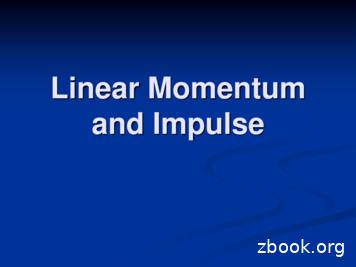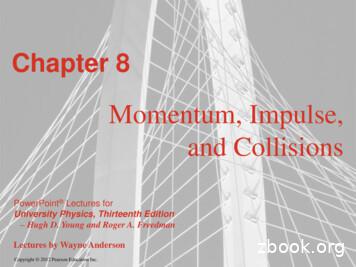Linear Momentum And Impulse - Weebly
Linear Momentumand Impulse
Linear Momentum Linear momentum (p)is a vectorp is parallel to vUnit: kg·m/sThe net momentum ofa collection of objectsis the vector sum ofthe momentum of each objectp p mv p1 p2 p3 . m1v1 m2v2 m3v3 .
Momentum problemA bullet of mass 0.005 kg moving at a speed of 100m/s lodges within a 1-kg block of wood restingon a frictionless surface and attached to ahorizontal spring of k 50N/m.m1v1 m2 v2 m1v1' m2 v2'a)What is the velocityof the block theinstant after thebullet strikes it?m1v1 0 (m1 m2 )v 'm1v1v m1 m2'(0.005kg)(100m / s) 0.005kg 1.00kg 0.50m / s
Momentum problemA bullet of mass 0.005 kg moving at a speed of100 m/s lodges within a 1-kg block of woodresting on a frictionless surface and attachedto a horizontal spring of k 50N/m.ET ETb)What is the maximumcompression of thespring?12mv2 12 kx2mv 2x k(1.005kg)(0.5m / s ) 2 50 N / m 0.07m
Force and momentumThe time rate of changeof the momentum of aparticle is equal to thenet force acting onthe particle. dpFnet dt“Let the time rate of change ofmomentum be with you.”
Force and momentum In general, force andmomentum are related as: dp ddv dmFnet (mv ) m vdt dtdtdt When the mass isconstant, thisbecomes the familiarequation: dvFnet m madt
Non-constant mass Mass changes for rockets, bags of sand(with holes in them), and other specialcases.See below for a changing mass:http://eepybird.com/dcm1.html
Changing mass problemA rocket whose initial mass is 850kg consumesfuel at the rate of 2.3kg/s. The speed of theexhaust gases relative to the rocket engine is2800m/s. dpdv dmFnet m vWhat thrust does thedtdtdt dmrocket engine provide? 0 vdt (2800m / s )(2.3kg / s ) 6440 N
ImpulseImpulse (J) is a change inmomentum. dp Start with Newton’s second Law: F dtWhich can be written as: dp F (t )dtIntegrate with respect to time to find the change inpftf momentum:J dp F (t )dt pi ti
ImpulseA 2.0 kg toy car travels at 0.50m/s East before aturn and at 0.40m/s South after the turn.What is the impulse (change in momentum) of thecar due to the turn? J p p f pi mv f mvi m(v f vi ) (2.0kg) ( 0.40m / s ) ˆj (0.50m / s)iˆ (1.0iˆ 0.8 ˆj )kg m / s
Conservation of LinearMomentumThe linear momentum (p) of a system isconserved (does not change) unless thesystem experiences an external force.
ProblemAn 80-kg lumberjack stands at one end of afloating 400-kg log that is at rest relative to theshore of a lake.If the lumberjack jogs to the other end of the log at2m/s relative to the shore, what happens to thelog while he is moving?
Elastic collisionIn an elastic collision objects typically bounce, andNO energy is lost Momentum is conserved Kinetic energy is conserved pbefore pafterKbefore K after
Inelastic collisionIn a totally inelastic collision, objects stick together. Momentum is conserved Energy is lost to sound, sparks, mechanicaldeformation, etc. pbefore pafterKbefore K after
Example of Inelastic collision:Would you be safer in an old (heavy) 1959Chevrolet Bel Air or in a newer (lighter)2009 Chevy Malibu?http://www.youtube.com/watch?v fPF4fBGNK0U
Collision review Momentum is conserved in all collisionsElastic collisions: no deformation occurs Inelastic collisions: deformation occurs Kinetic energy is “lost”Perfectly inelastic collisions Kinetic energy is also conservedObjects stick together; kinetic energy is “lost”Explosions Reverse of perfectly inelastic collisions;kinetic energy is “gained”
Collision problemTwo skaters collide and embrace, in a completelyinelastic collision. Dean, of mass 83 kg, isinitially moving east with speed 6.2 m/s. Torvill,of mass 55 kg, is initially traveling north withspeed 7.8 m/s.What are the skaters’ speed and direction after thecollision?v 4.86m / s 4.9m / s 39.8 40
Momentum is conserved in all collisions Elastic collisions: no deformation occurs Kinetic energy is also conserved Inelastic collisions: deformation occurs Kinetic energy is "lost" Perfectly inelastic collisions Objects stick together; kinetic energy is "lost" Explosions Reverse of perfectly inelastic collisions;
1. Impulse and Momentum: You should understand impulse and linear momentum so you can: a. Relate mass, velocity, and linear momentum for a moving body, and calculate the total linear momentum of a system of bodies. Just use the good old momentum equation. b. Relate impulse to the change in linear momentum and the average force acting on a body.
CHAPTER 3 MOMENTUM AND IMPULSE prepared by Yew Sze Ling@Fiona, KML 2 3.1 Momentum and Impulse Momentum The linear momentum (or "momentum" for short) of an object is defined as the product of its mass and its velocity. p mv & & SI unit of momentum: kgms-1 or Ns Momentum is vector quantity that has the same direction as the velocity.
Lecture L10 - Angular Impulse and Momentum for a Particle In addition to the equations of linear impulse and momentum considered in the previous lecture, there is a parallel set of equations that relate the angular impulse and momentum. Angular Momentum We consider a particle of mass m,
Impulse and momentum The impulse of a force is the product of the force and the time interval during which it acts. On a graph of F x versus time, the impulse is equal to the area under the curve, as shown in figure to the right. Impulse-momentum theorem: The change in momentum of a particle during a time interval
Momentum Impulse Newton Graphing Impulse The simple definition for impulse is that it is a change in momentum. If an object’s velocity changes, there is a change in momentum, so there must be an impulse We assume that you are not going to change the mass of an object. Δp m Δv Δp impulse (change
4. Impulse - Momentum 3. This area is called Impulse F.dt r. 5/14/2008 Momentum - 1 25 Force, Time and Momentum The area under the force-time graph equals the change in linear momentum. If the LHS of this . Collisions - Linear Momentum is always conserved Is the collision force gravity or springs? - If YES, then Kinetic .
6.1 Momentum and Impulse ! Impulse – In the initial seconds of a collision, there is an impulse force on the object. ! This force is defined as the change in linear momentum: ! In order to change the momentum of an object, a force must be applied. ! The time rate of change of momentum of
Impulse, Momentum 2011, Richard White www.crashwhite.com ! This test covers momentum, impulse, conservation of momentum, elastic collisions, inelastic collisions, perfectly inelastic collisions, 2-D collisions, and center-of-mass, with some problems requiring a knowledge . Conservation of linear momentum cannot be used to find the final .























